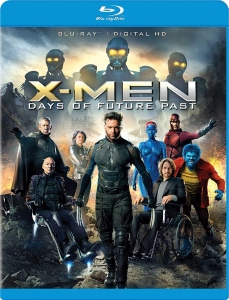Although I prefer the “X-Men” movies with smaller casts, and especially those that focus in on one character (the Wolverine movies are the only examples so far), “X-Men: Days of Future Past” is a pretty great example of a big-cast, big-idea blockbuster done right. Between director Bryan Singer (“X-Men” and “X2: X-Men United”), the three screenwriters and a bevy of returning actors, representatives from every prior film are on hand. But “Days of Future Past” avoids being a case of too many cooks spoiling the broth.
It owes a debt to ‘The Terminator’
“Days of Future Past” is the franchise’s seventh film, and chronologically, it’s the second … and the last, as it is set in both 1973 and 2023. The opening narration by older Professor Xavier (Patrick Stewart) doesn’t disguise its debt to “Terminator,” as he blatantly uses the phrase “The future is not set.”
However, Chris Claremont’s “Days of Future Past” comic books (1981) predate the “Terminator” franchise, so maybe the rip-off is the other way around. Having not read the comics, I don’t know how faithful this adaptation is.

“X-Men: Days of Future Past” (2014)
Director: Bryan Singer
Writers: Simon Kinberg, Jane Goldman, Matthew Vaughn
Stars: Patrick Stewart, Ian McKellen, Hugh Jackman
The 2023 portion of the movie is set in a bleak apocalyptic wasteland where the X-Men are holed up in a building as Sentinels loom nearby. Basically, Sentinels are giant Terminators that have Rogue’s ability to take on the aspects of any mutant.
(Rogue fans will be disappointed, as she only has a cameo, and her connection to the Sentinels – if any — isn’t explained. The film focuses on Mystique’s connection to them, which doesn’t totally make sense because her ability is strictly shape-shifting whereas the Sentinels don’t shift shape so much as they shift through a wide range of deadly abilities.)
In the bunker, Kitty Pryde (Ellen Page) uses her power to send Wolverine’s (Hugh Jackman) mind back through time into his 1973 self. (Conveniently for filming purposes, Wolverine does not age due to his healing ability.) There’s not a whole lot for Stewart and Ian McKellen (old Magneto) to do except wring their hands, but the younger 2023 characters get to star in cool action sequences.
Blink and you’ll miss her
My favorite new X-Man from this batch is Blink (Bingbing Fan), who can create little portals to send a teammate to a different part of the battlefield to sneak up on a Sentinel. And if I recall correctly from sifting through a buddy’s “X-Men” longboxes years ago, Omar Sy is visually a spot-on Bishop, although I’ll need a comic reader to explain what exactly his power is.
The coolest action sequence in the movie, and one that rivals the zero-gee segment of “Inception,” is when Quicksilver (Evan Peters) uses his super-speed to rescue Magneto from a cell beneath the Pentagon to kick off the 1973 portion of the story. As viewers, we see Quicksilver’s perspective as he leisurely sends bullets off course and knocks out all the security guards as if time is standing still.

It’s also neat to see various 1970s accoutrements, and the film does a respectable job of avoiding anachronisms. At one point, Beast (Nicholas Hoult) needs to show Wolverine and young Xavier (James McAvoy) some news clips. A lesser movie would’ve said “What the heck, let’s just give him a VCR.” “Future Past,” respecting real-world history, has Beast show off his personally designed set-up replete with a huge computer keyboard, TVs and reel-to-reel tapes where he can record “all three channels, plus PBS.”
Writers Simon Kinberg, Jane Goldman and Matthew Vaughn faced quite a juggling act with all these characters, but they find a nice balance by focusing on four of them and letting a few others have cool supporting roles (or less-than-cameos, in the case of Rogue; but Storm fans should be happy). The four featured characters are Wolverine, young Xavier, young Magneto (Michael Fassbender) and Mystique (Jennifer Lawrence). Coincidentally or not, they happen to be played be four fine actors.
Mystique’s mysterious allegiances
Building on Mystique’s wishy-washy allegiance in “X-Men: First Class” (2011), set in 1962, the 1973 plot pivots around her. She aims to kill weapons designer Trask (Peter Dinklage) before he sells his Sentinels to a major government. But Wolverine, Xavier and Magneto aim to stop her, because Wolverine knows if she succeeds, the plan will actually backfire on her and the government will purchase the Sentinels to wipe out mutant-kind, since they will see Mystique as an example of the threat they face.
Admittedly, I wasn’t clear on what the good guys were doing for most of the movie, but it crystalized for me at the end. (By the way, Mystique must have a slow-aging ability similar to Wolverine’s. In her natural form, she looks only a few years older during a span of 11 years, then ages only about 10 years by the time we see her 30 years down the road in the original “X-Men,” when she’s played by Rebecca Romijn.)
While “Future Past” features epic set pieces of Magneto lifting up a baseball stadium and Sentinels rising up with guns blazing, the film is driven by character motivations, and that’s why it works. There are no cliched villains here – although I must say the guy playing Richard Nixon does a decent impression. I like how Trask starts out as the villain, but then Magneto takes over that role.
History repeats
Granted, the franchise is repeating the conflict from previous films – Xavier believes mutants can live peacefully with Homo sapiens, while Magneto believes it’s kill or be killed. To me, it felt fresh enough, although that might be because I haven’t done a re-watch of the first six films recently.
Even with its time-travel and multiple-timelines elements, I don’t think “Future Past” smooths over many of the contradictions from previous films, such as the multiple identities of Emma Frost and Moira MacTaggart.
And come to think of it, “Future Past” really can’t make up its mind if “the future is not set” or if the future is like a stream that always continues on its path regardless of ripples from a stone. Ultimately, it turns out that the future is not set when it comes to horrors such as the Sentinels, but it is set when it comes to all of Wolverine’s X-Men buddies still being alive and well. That sure is convenient.
It’s easy to quibble – and indeed, I aim to read a few articles about the film’s continuity errors (it’s becoming a franchise tradition). But as a piece of mass-audience blockbuster cinema, “X-Men: Days of Future Past” is still smarter than most.

